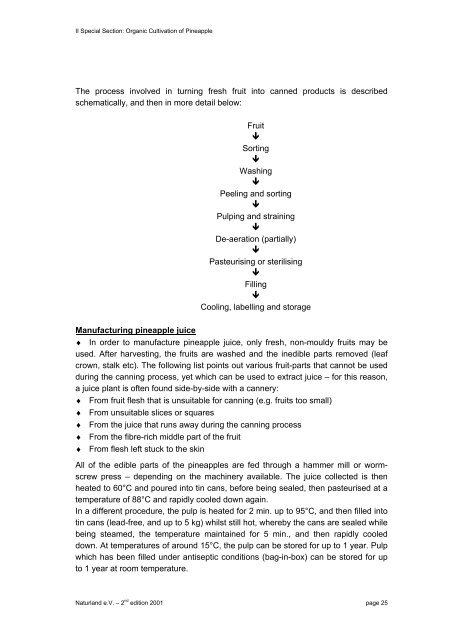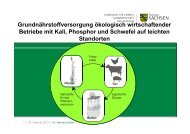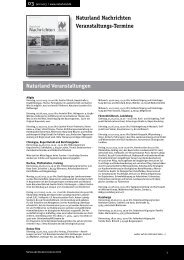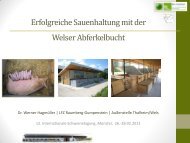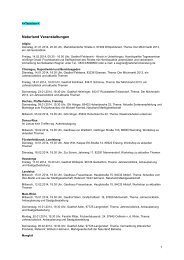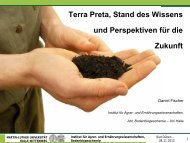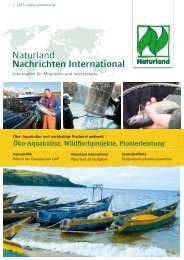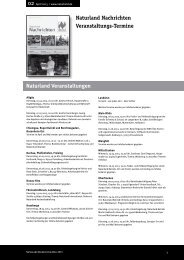Organic Farming in the Tropics and Subtropics: Pineapple - Naturland
Organic Farming in the Tropics and Subtropics: Pineapple - Naturland
Organic Farming in the Tropics and Subtropics: Pineapple - Naturland
You also want an ePaper? Increase the reach of your titles
YUMPU automatically turns print PDFs into web optimized ePapers that Google loves.
II Special Section: <strong>Organic</strong> Cultivation of P<strong>in</strong>eapple<br />
The process <strong>in</strong>volved <strong>in</strong> turn<strong>in</strong>g fresh fruit <strong>in</strong>to canned products is described<br />
schematically, <strong>and</strong> <strong>the</strong>n <strong>in</strong> more detail below:<br />
Manufactur<strong>in</strong>g p<strong>in</strong>eapple juice<br />
Fruit<br />
�<br />
Sort<strong>in</strong>g<br />
�<br />
Wash<strong>in</strong>g<br />
�<br />
Peel<strong>in</strong>g <strong>and</strong> sort<strong>in</strong>g<br />
�<br />
Pulp<strong>in</strong>g <strong>and</strong> stra<strong>in</strong><strong>in</strong>g<br />
�<br />
De-aeration (partially)<br />
�<br />
Pasteuris<strong>in</strong>g or sterilis<strong>in</strong>g<br />
�<br />
Fill<strong>in</strong>g<br />
�<br />
Cool<strong>in</strong>g, labell<strong>in</strong>g <strong>and</strong> storage<br />
♦ In order to manufacture p<strong>in</strong>eapple juice, only fresh, non-mouldy fruits may be<br />
used. After harvest<strong>in</strong>g, <strong>the</strong> fruits are washed <strong>and</strong> <strong>the</strong> <strong>in</strong>edible parts removed (leaf<br />
crown, stalk etc). The follow<strong>in</strong>g list po<strong>in</strong>ts out various fruit-parts that cannot be used<br />
dur<strong>in</strong>g <strong>the</strong> cann<strong>in</strong>g process, yet which can be used to extract juice – for this reason,<br />
a juice plant is often found side-by-side with a cannery:<br />
♦ From fruit flesh that is unsuitable for cann<strong>in</strong>g (e.g. fruits too small)<br />
♦ From unsuitable slices or squares<br />
♦ From <strong>the</strong> juice that runs away dur<strong>in</strong>g <strong>the</strong> cann<strong>in</strong>g process<br />
♦ From <strong>the</strong> fibre-rich middle part of <strong>the</strong> fruit<br />
♦ From flesh left stuck to <strong>the</strong> sk<strong>in</strong><br />
All of <strong>the</strong> edible parts of <strong>the</strong> p<strong>in</strong>eapples are fed through a hammer mill or wormscrew<br />
press – depend<strong>in</strong>g on <strong>the</strong> mach<strong>in</strong>ery available. The juice collected is <strong>the</strong>n<br />
heated to 60°C <strong>and</strong> poured <strong>in</strong>to t<strong>in</strong> cans, before be<strong>in</strong>g sealed, <strong>the</strong>n pasteurised at a<br />
temperature of 88°C <strong>and</strong> rapidly cooled down aga<strong>in</strong>.<br />
In a different procedure, <strong>the</strong> pulp is heated for 2 m<strong>in</strong>. up to 95°C, <strong>and</strong> <strong>the</strong>n filled <strong>in</strong>to<br />
t<strong>in</strong> cans (lead-free, <strong>and</strong> up to 5 kg) whilst still hot, whereby <strong>the</strong> cans are sealed while<br />
be<strong>in</strong>g steamed, <strong>the</strong> temperature ma<strong>in</strong>ta<strong>in</strong>ed for 5 m<strong>in</strong>., <strong>and</strong> <strong>the</strong>n rapidly cooled<br />
down. At temperatures of around 15°C, <strong>the</strong> pulp can be stored for up to 1 year. Pulp<br />
which has been filled under antiseptic conditions (bag-<strong>in</strong>-box) can be stored for up<br />
to 1 year at room temperature.<br />
Naturl<strong>and</strong> e.V. – 2 nd edition 2001 page 25


